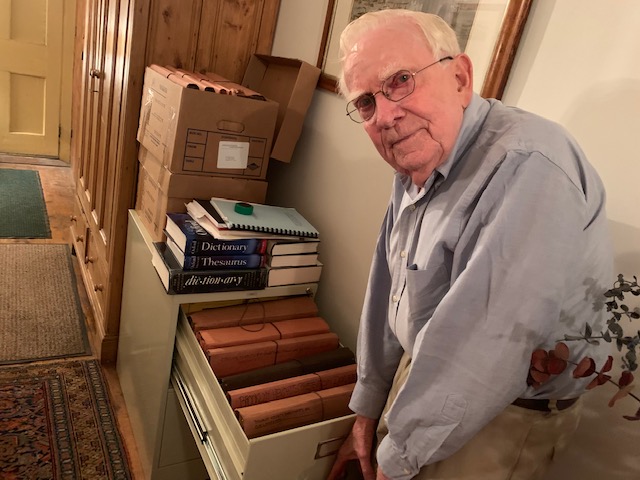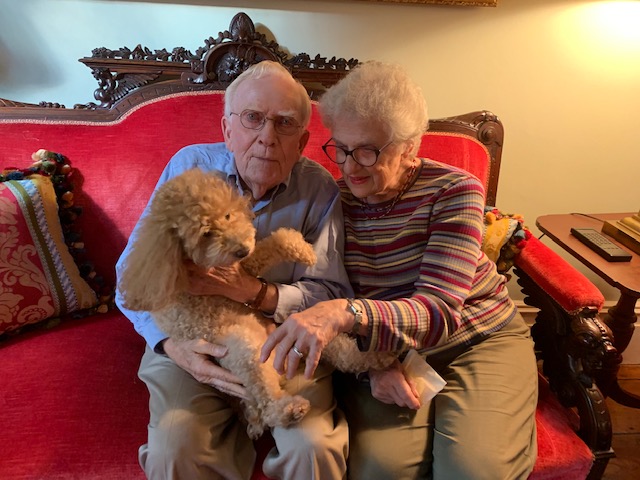Why We Tend Our Papers
January 16, 2020 | Elizabeth Rohn Jeffe, Vice Chair
Otis Pratt Pearsall on Keeping Accessible Archives

This September, Archive Project Vice-Chair Elizabeth Rohn Jeffe sat down with Otis Pratt Pearsall (and his wife Nancy Pearsall), legendary Brooklyn Heights preservationist and the 2019 Bard Birthday Breakfast Benefit honoree, to discuss his years of preservation service and his personal archival practices.
Thank you for having me to your home, Nancy and Otis. This is a wonderful house—so evocative of history! And so appropriate for our conversation!
Otis Pratt Pearsall: Yes, it’s one of the oldest Federal houses in New York City, dating to about 1825. It has a great many of its original details, such as molding, woodwork elements, doors, and fireplaces.
You are a giant in New York preservation history. Thanks to you, the seven-year battle (1958-1965) to designate Brooklyn Heights as a historic district is one of the best-documented preservation campaigns in NYC history. Did you keep your extensive records of your many preservation initiatives because you are a lawyer, or because you wanted to save the preservation story?
I saved the materials because I am a lawyer. I had a rigorous academic career at Yale Law School, and I developed the habit of keeping orderly records. Additionally, as a practicing attorney, especially in litigation, I found it essential to have case files. So, keeping my preservation papers was not a new thought. I’ve also kept all the speeches I made when I was accepting various preservation awards. I believe these speeches are referred to fairly frequently. And I even have in my possession the desk book I gave to the 84th Precinct outlining the criminality of failing to obey landmark laws. Somehow, I got that back!
I know that Nancy has been a partner in your work and was especially involved in the Brooklyn Heights designation effort.
Nancy contributed greatly to the Brooklyn Heights battle and enhanced our archives collection by creating a scrapbook. She has also been active with later initiatives. I should note that I’m not the only Landmark Lion in the family; Nancy is one as well.
How are your materials organized? How easily are they accessed?
They are in folders, in chronological order. I am able to access papers on virtually any initiative in which I was involved in the space of a weekend at the most. I have a deep reservoir of documents available at almost an instant’s notice. There’s one place to come, and that’s to me! It’s a great source of personal satisfaction.
Were you ever tempted to toss something? Do some favorite stories make you want to save more things—and others, fewer items?
I keep everything. I don’t save selectively. You never know what you might need. You can’t make judgments in advance; something could be pivotal later on. As for favorite projects, I must say that I am immensely proud of Brooklyn Bridge Park. That was a wonderful outcome. I wrote 100 pages on that particular battle—part of the book about my whole preservation story that I’m never going to write!
When and where have your archives been used in exhibitions and publications?
My archives have been used in a variety of places. For several years, the Activist New York exhibition at the Museum of the City of New York used a photo of Nancy and me studying a demolished building in Cadman Plaza, looking at a mantel as part of an effort to save architectural objects that could be salvaged and reused by people fixing up old houses that needed original details. I also lent the museum some papers of mine for that exhibition, including a flyer that they displayed. To their credit, they returned them!
The Brooklyn Historical Society has used my archival materials on a number of occasions, including the 20th anniversary exhibition for Clay Lancaster, who was a key player in the Brooklyn Heights designation effort. He surveyed and documented every house in the neighborhood to make the case for their historic importance as a district. My papers were also used for the 50th anniversary exhibition on the designation of Brooklyn Heights.
Of course, NYPAP’s Chair, Anthony C. Wood, used my archives extensively for his book, Preserving New York. I give him credit for his thorough study of all that material. And the local press still contacts me on “all things Brooklyn Heights.”
How often are you contacted by people for assistance with background on preservation history?
Very frequently. A couple of examples come to mind. When the GVSHP was looking to plan its 50th celebration, I sent them my archives related to the Village. They kept copies of those papers, and they now have an Otis P. Pearsall archival collection.
Another interesting inquiry came in just recently when a woman by the name of Christine Cipriani contacted me for information on Ada Louise Huxtable, about whom she is writing a biography. Ada Louise was greatly admired here in the Heights for her influential editorials in the late Sixties opposing the relocation of the Fort Greene meat market. The Lindsay administration wanted to put the market in the area that is today DUMBO. Ada Louise was a major force in helping us to keep that from happening. I was very impressed by Ms. Cipriani. She read everything I sent her, no matter how technical, and understood it.
Are there lesser-known preservation initiatives that you would like to share with our readers?
Several come to mind. One of the last things I did before I left my law practice was to write up the history of several such lesser initiatives. One of these involved a key addition to Fort Sterling Park. There was an empty lot, about to be auctioned off by the city. It was an open space providing a view to the water, and it would be unfortunate to have it developed and ruin that scenic perspective. So, we convinced the City Planning Commission, which was getting very low bids for the land because there was a tunnel beneath it, to designate the lot as parkland. Beverly Moss Spatt, who became chair of the LPC in 1974, was very helpful with this effort.
Another less widely-known initiative involved saving two dilapidated Greek Revival buildings east of the Unitarian Church, which was going to knock them down for a playground. We persuaded the church to sell them to Saint Ann’s School. The school considered tearing them down as well, but decided instead to fix the houses up and make them into apartments.
Another effort that was very rewarding was the saving of one of the “deep gardens” behind the houses on Remsen Street backing up to Grace Court. One of these deep garden lots had been spun off as a building lot and Charles Gwathmey was hired to create a “modern landmark.” He’s a wonderful architect, but this would not be in the aesthetic interest of the neighborhood. Luckily, the young man who had the contract on the property, a Mr. Epstein, was really sympathetic to our concerns—every once in a while you meet someone like this—and I got Grace Church to take over the contract and keep the garden area open.
Do you have any thoughts on a permanent repository for your archives?
I’ve sent packages of some projects to the Brooklyn Historical Society archives, and I gave some things to NYPAP. I’ve been holding on to my archives, because I thought I’d write a book, which won’t happen. I haven’t yet decided on a final place. I really want my papers to be respected.
